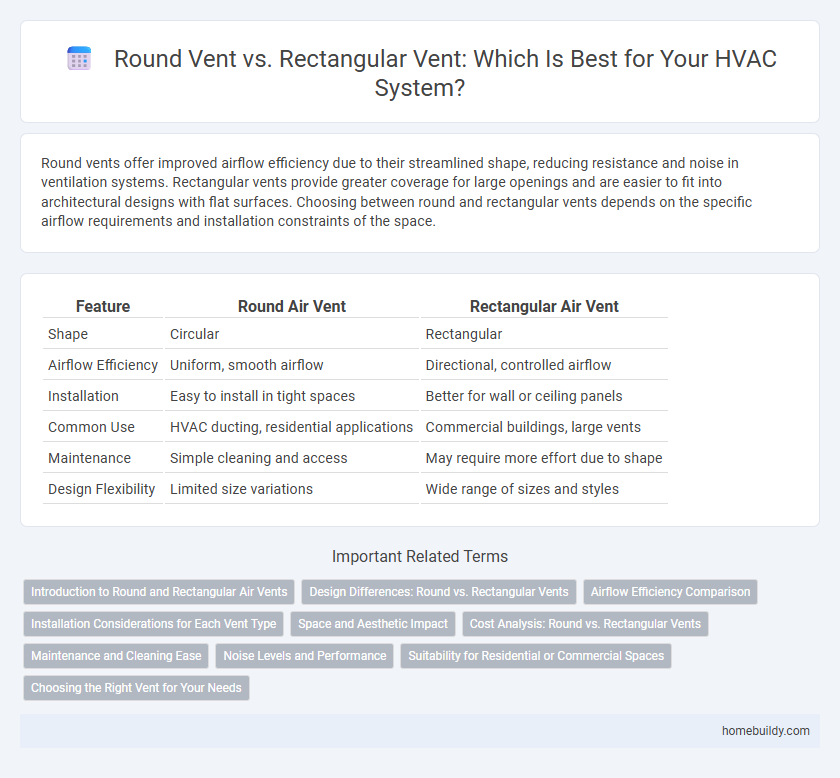Round vents offer improved airflow efficiency due to their streamlined shape, reducing resistance and noise in ventilation systems. Rectangular vents provide greater coverage for large openings and are easier to fit into architectural designs with flat surfaces. Choosing between round and rectangular vents depends on the specific airflow requirements and installation constraints of the space.
Table of Comparison
| Feature | Round Air Vent | Rectangular Air Vent |
|---|---|---|
| Shape | Circular | Rectangular |
| Airflow Efficiency | Uniform, smooth airflow | Directional, controlled airflow |
| Installation | Easy to install in tight spaces | Better for wall or ceiling panels |
| Common Use | HVAC ducting, residential applications | Commercial buildings, large vents |
| Maintenance | Simple cleaning and access | May require more effort due to shape |
| Design Flexibility | Limited size variations | Wide range of sizes and styles |
Introduction to Round and Rectangular Air Vents
Round air vents offer efficient airflow with minimal pressure loss, commonly used in HVAC systems for their ease of installation and aesthetic appeal. Rectangular air vents provide greater surface area for air distribution, ideal for larger spaces requiring uniform ventilation and precise control. Both vent shapes are designed to optimize airflow performance, tailored to specific architectural and functional requirements.
Design Differences: Round vs. Rectangular Vents
Round vents feature a circular design that promotes efficient airflow and reduces turbulence, making them ideal for systems requiring consistent air distribution. Rectangular vents offer versatility in installation and can cover larger surface areas, often preferred for aesthetic alignment with wall or ceiling grids. The choice between round and rectangular vents depends on specific spatial constraints and airflow requirements in HVAC design.
Airflow Efficiency Comparison
Round vents typically offer superior airflow efficiency due to their streamlined shape, which reduces turbulence and pressure drop within ducts. Rectangular vents often cause higher resistance and uneven distribution of air because of sharp corners and increased surface area. Studies show round vents can improve airflow rates by up to 20% compared to rectangular vents in HVAC systems.
Installation Considerations for Each Vent Type
Round vents typically require smaller, more precise openings and are easier to fit into existing circular ductwork, making installation faster and often less costly. Rectangular vents demand larger, more exact cutouts and may involve additional framing or structural adjustments, especially in walls or ceilings with limited space. The choice between round and rectangular vents significantly affects labor time, material requirements, and compatibility with HVAC systems.
Space and Aesthetic Impact
Round vents occupy less ceiling or wall space, making them ideal for compact areas where maximizing usable surface is crucial. Their smooth, circular design often blends seamlessly with modern decor, offering a minimalist aesthetic that complements various architectural styles. Rectangular vents provide a broader airflow distribution but can appear more intrusive, potentially disrupting sleek interior lines and requiring larger cutouts that impact wall or ceiling integrity.
Cost Analysis: Round vs. Rectangular Vents
Round vents typically cost less than rectangular vents due to simpler manufacturing processes and reduced material usage. Rectangular vents often require custom sizing and additional framing, increasing installation labor and overall expenses. Choosing between round and rectangular vents depends on budget constraints and specific airflow requirements for efficient cost management.
Maintenance and Cleaning Ease
Round vents typically offer easier maintenance and cleaning due to their smooth curves and fewer corners where dust and debris can accumulate. Rectangular vents, with their multiple edges and corners, often require more effort and specialized tools to thoroughly clean. Regular cleaning of round vents is more efficient, reducing the risk of airflow obstruction and promoting better indoor air quality.
Noise Levels and Performance
Round vents typically produce lower noise levels due to their streamlined airflow design, which reduces turbulence compared to rectangular vents. Rectangular vents often cause increased air resistance and can generate more noise, especially in high-velocity systems. Performance-wise, round vents maintain consistent air pressure and efficient airflow, enhancing ventilation effectiveness in residential and commercial spaces.
Suitability for Residential or Commercial Spaces
Round vents are ideal for residential spaces due to their efficient airflow distribution and aesthetically pleasing design that blends seamlessly with home interiors. Rectangular vents offer greater versatility and higher airflow capacity, making them better suited for commercial environments requiring robust ventilation systems. Choosing between round and rectangular vents depends on space requirements, airflow needs, and architectural design considerations in residential versus commercial settings.
Choosing the Right Vent for Your Needs
Round vents offer superior airflow efficiency and are ideal for systems requiring high air volume with minimal resistance, often used in residential ductwork. Rectangular vents provide better fit and coverage for wall or ceiling installations, making them suitable for spaces with architectural constraints or specific aesthetic preferences. Selecting the right vent depends on balancing airflow requirements, installation space, and design considerations to optimize HVAC performance.
round vent vs rectangular vent Infographic

 homebuildy.com
homebuildy.com